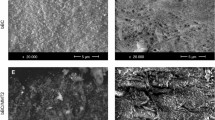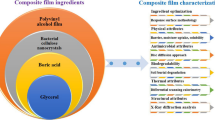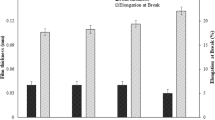Abstract
Active packaging materials are the subject of research because their performance exceeds that of traditional packaging. From this class, antimicrobial materials extend the shelf-life of products and reduce the risk of contamination by pathogens. In this paper, new composite materials with antimicrobial properties are obtained by using polyvinyl alcohol and bacterial cellulose powder. Potassium (2E,4E)-hexa-2,4-dienoate was used as the antimicrobial agent. The films thus obtained were characterised using Fourier-transform infrared spectroscopy and scanning electron microscopy. Mass transfer phenomena concerning the release of potassium (2E,4E)-hexa-2,4-dienoate were investigated. The results indicated that the new biocomposite films could be used as antimicrobial packaging materials.
Similar content being viewed by others
References
Alves, V., Costa, N., Hilliou, L., Larotonda, F., Gonçalves, M., Sereno, A., & Coelhoso, I. (2006). Design of biodegradable composite films for food packaging. Desalination, 199, 331–333. DOI: 10.1016/j.desal.2006.03.078.
Asran, A. S., Henning, S., & Michler, G. H. (2010). Polyvinyl alcohol-collagen-hydroxyapatite biocomposite nanofibrous scaffold: Mimicking the key features of natural bone at the nanoscale level. Polymer, 51, 868–876. DOI: 10.1016/j.polymer.2009.12.046.
Choi, J. H., Choi, W. Y., Cha, D. S., Chinnan, M. J., Park, H. J., Leed, D. S., & Park, J. M. (2005). Diffusivity of potassium sorbate in κ-carrageenan based antimicrobial film. LWT — Food Science and Technology, 38, 417–423. DOI: 10.1016/j.lwt.2004.07.004.
Crank, J. (1975). The mathematics of diffusion (2nd ed., pp. 47–53, 244, 254–257). Oxford, UK: Oxford University Press.
Czaja, W., Krystynowicz, A., Bielecki, S., & Brown, R. M., Jr. (2006). Microbial cellulose-the natural power to heal wounds. Biomaterials, 27, 145–151. DOI: 10.1016/j.biomaterials.2005.07.035.
Dainelli, D., Gontard, N., Spyropoulos, D., Zondervan-van den Beuken, E., & Tobback, P. (2008). Active and intelligent food packaging: legal aspects and safety concerns. Trends in Food Science & Technology, 19, S103–S112. DOI: 10.1016/j.tifs.2008.09.011.
Deore, R. K., Kavitha, K., & Tamizhmani, T. G. (2010). Preparation and evaluation of sustained release matrix tablets of tramadol hydrochloride using glyceryl palmitostearate. Tropical Journal of Pharmaceutical Research, 9, 275–281.
Khare, A., & Deshmukh, S. (2006). Studies toward producing eco-friendly plastics. Journal of Plastic Films and Sheeting, 22, 193–211. DOI: 10.1177/8756087906067324.
Liu, F., Qin, B., He, L., & Song, R. (2009). Novel starch/chitosan blending membrane: Antibacterial, permeable and mechanical properties. Carbohydrate Polymers, 78, 146–150. DOI: 10.1016/j.carbpol.2009.03.021.
Liu, Y., Geever, L. M., Kennedy, J. E., Higginbotham, C. L., Cahill, P. A., & McGuinness, G. B. (2010). Thermal behavior and mechanical properties of physically crosslinked PVA/Gelatin hydrogels. Journal of the Mechanical Behavior of Biomedical Materials, 3, 203–209. DOI: 10.1016/j.jmbbm.2009.07.001.
Musial, W., Kokol, V., & Voncina, B. (2010a). Lidocaine hydrochloride preparations with ionic and non-ionic polymers assessed at standard and increased skin surface temperatures. Chemical Papers, 64, 84–90. DOI: 10.2478/s11696-009-0089-4.
Musial, W., Kokol, V., & Voncina, B. (2010b). Deposition and release of chlorhexidine from non-ionic and anionic polymer matrices. Chemical Papers, 64, 346–353. DOI: 10.2478/s11696-010-0013-y.
Patil, S. B., Kulkarni, U., & Bhavik, P. (2010). Formulation and evaluation of diclofenac potassium matrix tablets. International Journal of Pharmaceutical Sciences and Research, 1(8) Supplement, 88–92.
Peppas, N. A. (1985). Analysis of Fickian and non-Fickian drug release from polymers. Pharmaceutica Acta Helvetiae, 60, 110–111.
Quintavalla, S., & Vicini, L. (2002). Antimicrobial food packaging in meat industry. Meat Science, 62, 373–380. DOI: 10.1016/S0309-1740(02)00121-3.
Ritger, P. L., & Peppas, N. A. (1987a). A simple equation for description of solute release I. Fickian and non-Fickian release from non-swellable devices in the form of slabs, spheres, cylinders or discs. Journal of Controlled Release, 5, 23–36. DOI: 10.1016/0168-3659(87)90034-4.
Ritger, P. L., & Peppas, N. A. (1987b). A simple equation for description of solute release II. Fickian and anomalous release from swellable devices. Journal of Controlled Release, 5, 37–42. DOI: 10.1016/0168-3659(87)90035-6.
Shen, X. L., Wu, J. M., Chen, Y., & Zhao, G. (2010). Antimicrobial and physical properties of sweet potato starch films incorporated with potassium sorbate or chitosan. Food Hydrocolloids, 24, 285–290. DOI: 10.1016/j.foodhyd.2009.10.003.
Siepmann, J., & Siepmann, F. (2008). Mathematical modeling of drug delivery. International Journal of Pharmaceutics, 364, 328–343. DOI: 10.1016/j.ijpharm.2008.09.004.
Stoica-Guzun, A., Jecu, L., Gheorghe, A., Raut, I., Stroescu, M., Ghiurea, M., Danila, M., Jipa, I., & Fruth, V. (2011). Biodegradation of poly(vinyl alcohol) and bacterial cellulose composites by Aspergillus niger. Journal of Polymers and the Environment, 19, 69–79. DOI: 10.1007/s10924-010-0257-1.
Yoshida, C. M. P., Bastor, C. E. N., & Franco, T. T. (2010). Modeling of potassium sorbate diffusion through chitosan films. LWT — Food Science and Technology, 43, 584–589. DOI: 10.1016/j.lwt.2009.10.005.
Yoshimi, T., Sugiyama, N., Takeoka, Y., Rikukawa, M., Oribe, K., & Aizawa, M. (2011). Changes of material properties of inorganic/organic hybrids fabricated by infiltration of poly(L-lactic acid) into open pores of porous hydroxyapatite ceramics in a simulated body fluid. Journal of the Australian Ceramic Society, 47, 18–22.
Author information
Authors and Affiliations
Corresponding author
Rights and permissions
About this article
Cite this article
Jipa, I.M., Stoica, A., Stroescu, M. et al. Potassium sorbate release from poly(vinyl alcohol)-bacterial cellulose films. Chem. Pap. 66, 138–143 (2012). https://doi.org/10.2478/s11696-011-0068-4
Received:
Revised:
Accepted:
Published:
Issue Date:
DOI: https://doi.org/10.2478/s11696-011-0068-4




